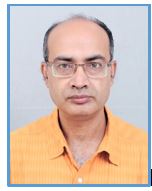| Course Status : | Completed |
| Course Type : | Elective |
| Language for course content : | English |
| Duration : | 12 weeks |
| Category : |
|
| Credit Points : | 3 |
| Level : | Undergraduate/Postgraduate |
| Start Date : | 24 Jan 2022 |
| End Date : | 15 Apr 2022 |
| Enrollment Ends : | 07 Feb 2022 |
| Exam Date : | 23 Apr 2022 IST |
Note: This exam date is subject to change based on seat availability. You can check final exam date on your hall ticket.
Week 1: Preliminaries, Biomedical signal origin & dynamics (ECG), Biomedical signal origin & dynamics (EEG, EMG etc.)
Week 2: Filtering for Removal of artifacts: Statistical Preliminaries, Time domain filtering (Synchronized Averaging, Moving Average), Time domain filtering (Moving Average Filter to Integration, Derivative-based operator), Frequency Domain Filtering (Notch Filter), Optimal Filtering: The Weiner Filter.
Week 3:Filtering for Removal of artifacts contd.: Optimal Filtering: The Weiner Filter, Adaptive Filtering Selecting Appropriate Filter
Week 4:Event Detection: Example events (viz. P, QRS and T wave in ECG), Derivative based Approaches for QRS Detection Pan Tompkins Algorithm for QRS Detection, Dicrotic Notch Detection Correlation Analysis of EEG Signal
Week 5:Waveform Analysis: Illustrations of problem with case studies, Morphological Analysis of ECG, Correlation coefficient, The Minimum phase correspondent.
Week 6:Waveform Analysis contd.: Signal length, Envelop Extraction, Amplitude demodulation, The Envelogram, Analysis of activity, Root Mean Square value, Zero-crossing rate, Turns Count, Form factor.
Week 7:Frequency-domain Analysis: Periodogram, Averaged Periodogram, Blackman-Tukey Spectral Estimator, Daniell's Spectral Estimator, Measures derived from PSD.
Week 8:Modelling of Biomedical Systems: Motor unit firing pattern, Cardiac rhythm, Formants and pitch of speech, Point process, Parametric system modelling, Autoregressive model, Autocorrelation method, Application to random signals, Computation of model parameters, Levinson-Durbin algorithm, Computation of gain factor, Covariance method, Spectral matching and parameterization, Model order selection, Relation between AR and Cepstral coefficients.
Week 9:bModelling of Biomedical Systems & Tutorials: ARMA model, Sequential estimation of poles and zeros, Tutorial 1.1: Notch filter design, Tutorial 1.2: Synchronized averaging, Tutorial 1.3: Design Butterworth low pass filter.
Week 10:Tutorials: Tutorial 2.1: Design derivative-based filter, Tutorial 2.2: Design Butterworth high pass filter, Tutorial 2.3: Design Wiener filter, Tutorial 3.1: Implement the Pan-Tompkins method for QRS detection.
Week 11:Tutorials: Tutorial 3.2: Use cross-correlation to detect alpha rhythm, Tutorial 3.3: Design a matched filter, Tutorial 3.4: Pan-Tompkins method for QRS detection and the Lehner and Rangayyan method to detect dicrotic notch, Tutorial 4.1: Half wave and full wave rectification, Tutorial 4.2: RMS value calculation, Tutorial 4.3: Turns count calculation, Tutorial 4.4: RMS, Turns count and Zero-crossing rate calculations
Week 12: Tutorials: Tutorial 4.5: Derive the Envelogram, Tutorial 4.6: RR interval and Form Factor calculations, Tutorial 5.1: Power spectrum calculations using different windows, Tutorial 5.2: Mean frequency and variance of PSD, Tutorial 5.3: Compute PSDs of Voiced, Unvoiced and Silent portion of sound signal, Tutorial 5.4: Compute mean frequency of PSDs and ratio of energies, Tutorial 5.5: Study the changes in the PSDs by varying window width, number of segments averaged, and type of the window used.
Thanks to the support from MathWorks, enrolled students have access to MATLAB for the duration of the course.

DOWNLOAD APP
FOLLOW US